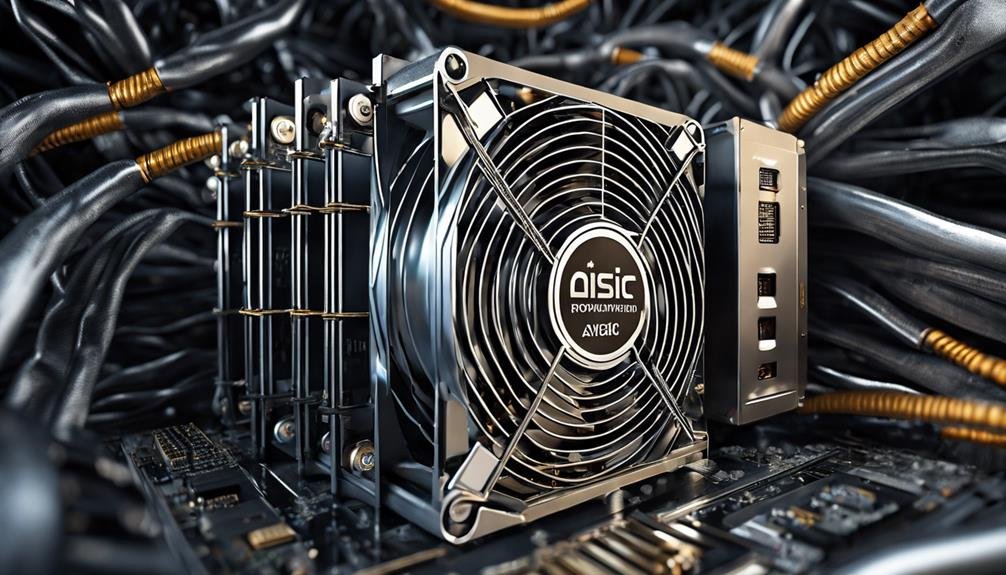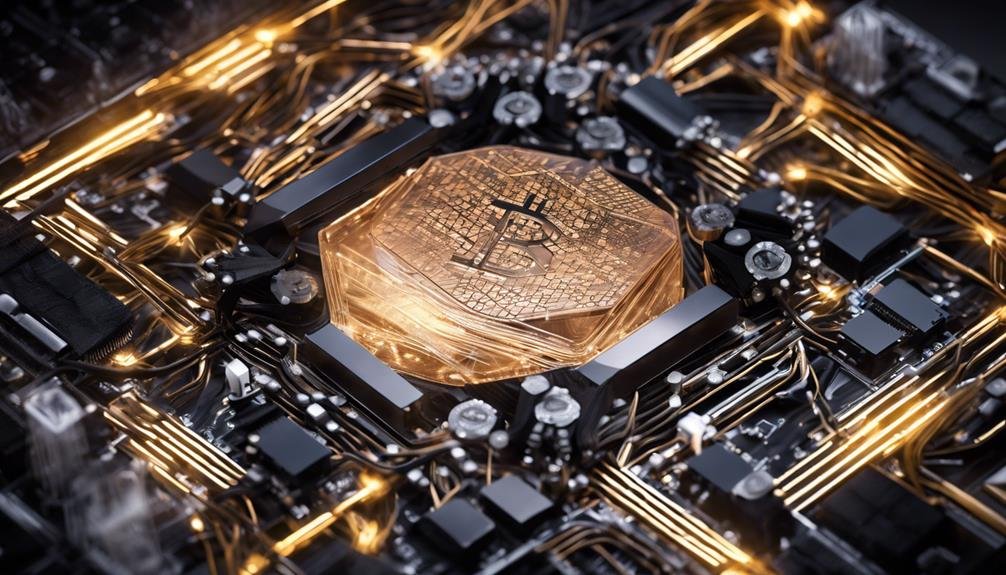ASIC miners have brought a subtle yet significant shift to the landscape of Bitcoin mining, altering the efficiency and speed at which transactions are processed. Introducing these specialized devices has prompted a fundamental evolution in the mining process.
Still, the implications stretch beyond mere technological advancements. As you explore the impact of ASIC miners on the decentralized nature of Bitcoin mining, a deeper understanding of the complexities and controversies surrounding this transformation will emerge, shedding light on the intricate dynamics within the cryptocurrency ecosystem.
Table of Contents
Key Takeaways
- ASIC miners optimize efficiency, outperforming CPUs and GPUs.
- High terahash rates of ASIC miners boost network security.
- ASIC mining promotes environmental sustainability and energy efficiency.
- Centralization concerns necessitate monitoring for network stability.
Impact of ASIC Miners on Efficiency

The introduction of ASIC miners has drastically enhanced efficiency in Bitcoin mining operations, setting a new standard for speed and hash rates. ASIC miners are designed to tackle the cryptographic puzzles required for mining, specially optimized for the SHA-256 algorithm used in Bitcoin. This tailored design guarantees that ASIC miners outperform CPUs and GPUs, offering unparalleled efficiency that significantly reduces operational costs for miners.
With the improved efficiency of ASIC miners, the Bitcoin mining industry has become more competitive and professional. Miners now have access to technology that not only boosts transaction processing speeds but also enhances the network’s overall security. ASIC miners have revolutionized the landscape of Bitcoin mining, ushering in an era where high-speed, low-cost operations are the norm. This transformation has increased the profitability of mining and fortified the network against potential security threats, solidifying Bitcoin’s position as a secure and efficient cryptocurrency.
Cost Reduction With ASIC Miners

Introducing ASIC miners into your Bitcoin mining operations can significantly reduce costs while maximizing efficiency and profitability. ASIC miners are designed to lower operational costs by offering higher efficiency and reducing energy consumption compared to traditional mining hardware.
This specialized design makes ASIC miners highly cost-effective, allowing miners to optimize their profitability in the competitive mining industry. By achieving higher hash rates at a fraction of the energy costs, ASIC miners pave the way for substantial cost reductions over time.
The cost reduction benefits associated with ASIC miners have transformed the economics of Bitcoin mining, making it more accessible and profitable for miners of all sizes. Mining with ASIC miners reduces expenses and provides a competitive edge by increasing mining rewards.
This drives the widespread adoption of ASIC miners and reinforces their position as a critical technology in the mining sector.
Increased Hashrate With ASIC Miners

With ASIC miners, the exponential increase in Bitcoin mining hash rates has reshaped the cryptocurrency mining landscape, propelling efficiency to unprecedented levels. The shift from CPU mining, measured in mere megahashes per second (MH/s), to the latest ASIC models achieving tens of terahashes per second (TH/s) signifies a monumental leap in performance.
ASIC miners like the Antminer S21 exemplify this progress by surpassing 100 TH/s, demonstrating the rapid evolution and enhanced efficiency in Bitcoin mining hardware.
These performance improvements have revolutionized the competitive nature of Bitcoin mining, compelling miners to upgrade continually to maintain profitability.
The heightened hash rates facilitated by ASIC miners not only expedite block validations and transaction processing on the network but also considerably bolster network security. The increased computational power contributes to making the Bitcoin blockchain more resilient against potential malicious attacks, safeguarding the entire system’s integrity.
ASIC miners have undeniably played a pivotal role in fortifying the efficiency and security of Bitcoin mining operations.
Environmental Implications of ASIC Mining

Amidst the rapid expansion of ASIC mining operations, the environmental ramifications of heightened electricity consumption are becoming increasingly concerning. It is essential to address the environmental implications of ASIC mining to aim for sustainability and reduce the industry’s carbon footprint. Here are critical considerations regarding the environmental impact of ASIC mining:
- Energy Efficiency: Enhancing energy efficiency in ASIC mining can significantly decrease the electricity demands of mining operations, thereby lowering carbon emissions and mitigating environmental harm.
- Renewable Energy Utilization: Embracing renewable energy sources such as solar or wind power can help offset the environmental impact of ASIC mining by reducing reliance on fossil fuels and promoting eco-friendly practices.
- Proper Disposal Practices: The proper disposal and recycling of outdated ASIC miners are essential to minimize electronic waste and prevent environmental degradation. Implementing sustainable disposal practices is vital for maintaining environmental sustainability within the ASIC mining industry.
Centralization Concerns in ASIC Mining

Centralization concerns loom large in ASIC mining as the concentration of mining power in large farms with advanced hardware continues to spark debate within the cryptocurrency community. The dominance of a few entities in ASIC mining operations raises questions about the overall decentralization of the network.
Large mining farms equipped with cutting-edge ASIC hardware can amass significant mining power, potentially leading to a small number of players controlling a substantial portion of the network’s hash rate. This concentration of mining power poses risks to network security. It challenges the fundamental principles of decentralization upon which cryptocurrencies are built.
Regulatory bodies closely monitor the situation to establish a balanced ecosystem where no single entity holds undue influence over the network. Addressing centralization concerns in ASIC mining is vital for maintaining a fair and competitive landscape that fosters innovation while upholding the security and integrity of cryptocurrency networks.
By promoting a more distributed mining landscape, the cryptocurrency community can work towards mitigating the risks associated with centralized mining power and fostering a more resilient network.
Frequently Asked Questions
What Role Does an ASIC Play in Bitcoin?
ASICs play a pivotal role in Bitcoin by maximizing efficiency and performance. Their specialized technology dominates mining, driving innovation and impacting the market. ASICs’ development and adoption have revolutionized competition, shaping the future of Bitcoin mining.
What Are the Advantages of ASIC Miner?
ASIC miners offer unparalleled advantages: energy efficiency, speed performance, cost-effectiveness, high hash rates, mining pool dominance, hardware investment needs, network security, difficulty adjustment, centralization risks, and durability. These features drive the mining industry’s evolution.
Is Mining With ASIC Profitable?
Mining with ASICs offers high mining efficiency, impacting profit margins. Consider electricity costs, hardware maintenance, and network competition. Higher hash rates enhance block rewards in mining pools. Evaluate ROI potential with cooling solutions for best performance.
Conclusion
You’ve witnessed the transformative power of ASIC miners in revolutionizing Bitcoin mining. The efficiency gains have been staggering, exponentially reducing costs and increasing hash rates. However, the environmental impact and centralization concerns loom, casting a shadow over these technological marvels.
As you marvel at the speed and efficiency of ASIC miners, remember to contemplate the broader implications and challenges they bring to the decentralized landscape of cryptocurrency mining.



